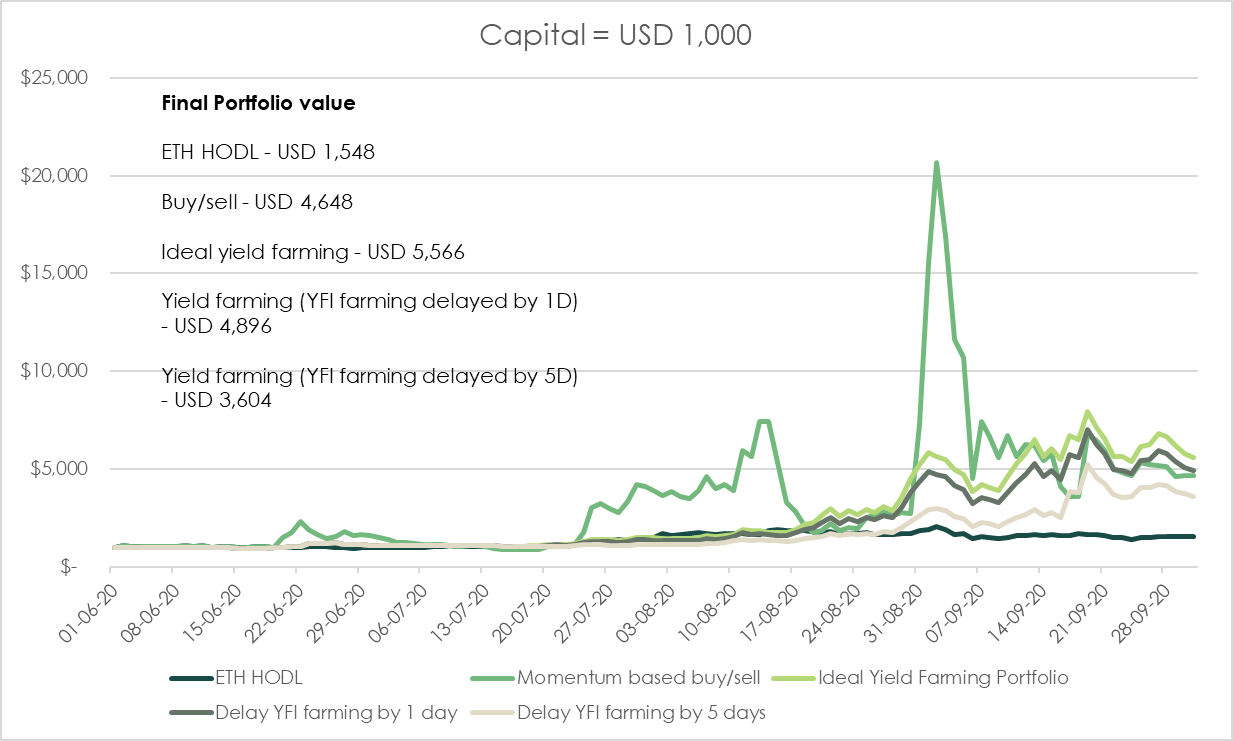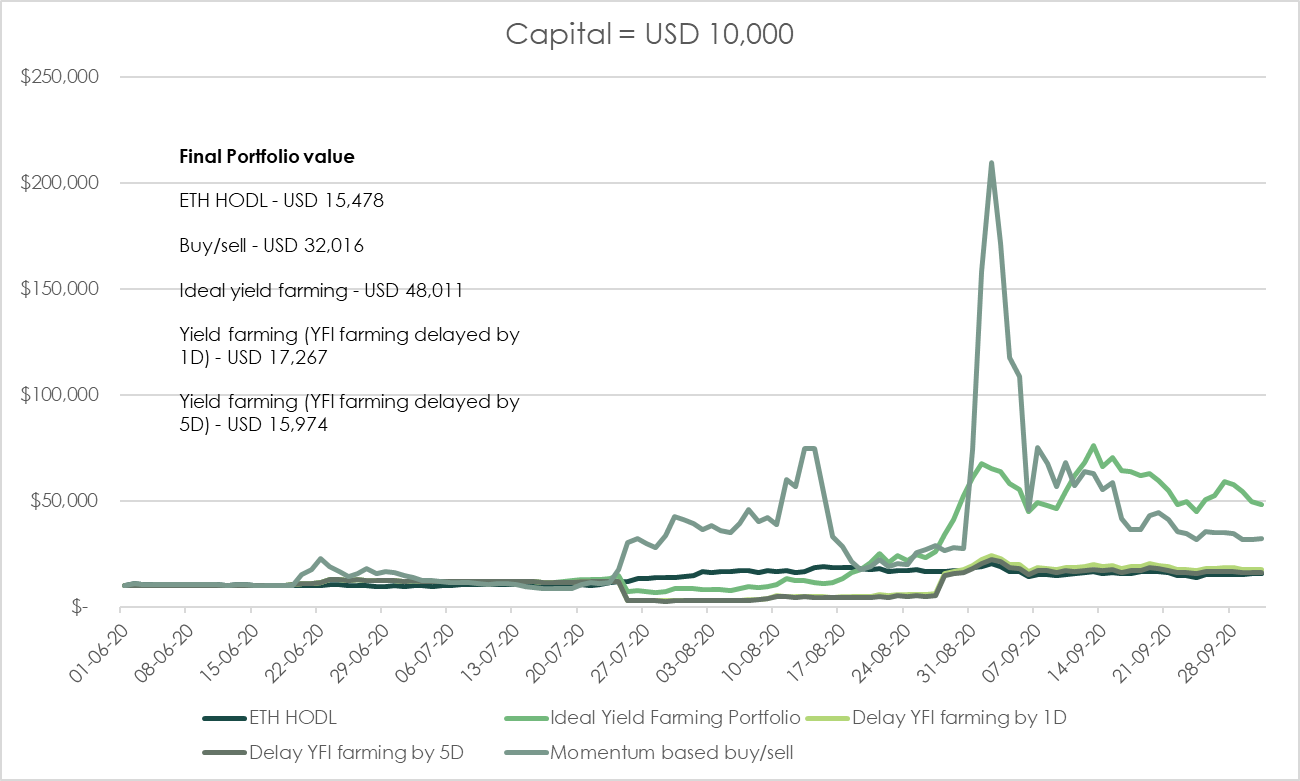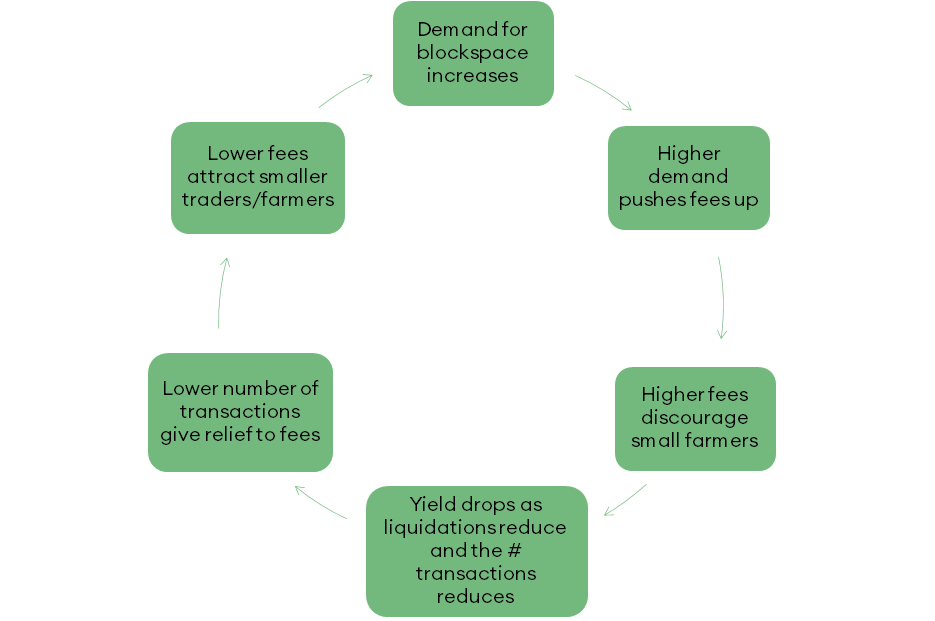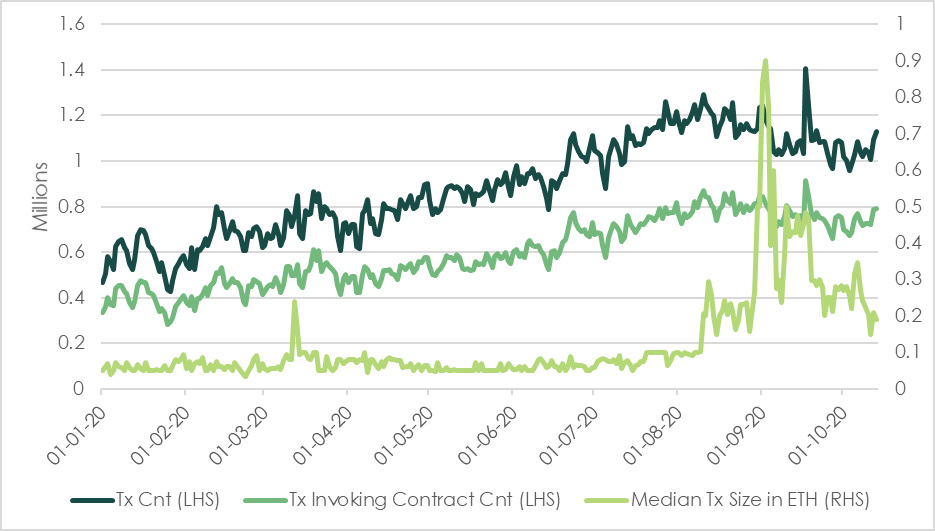...continued from Part 1.
Co-authored by Eric Choy, CFA, Strategist at PANONY, and Saurabh Deshpande, Digital Assets Research, B&B Analytics| SEBA
Portfolio performance: HODL ETH and yield farming governance token strategies
An important consideration while yield farming is the transaction fee on Ethereum blockchain. Higher fee deters smaller yield farmers from switching liquidity from one platform to another. We estimate that the investor would have to spend USD 346 in total fee to be able to farm only four tokens.
We compare two different portfolio sizes: USD 1,000 and USD 10,000. We considered four protocols – Balancer (BAL), Compound (COMP), Yearn Finance (YFI), and Sushiswap (SUSHI).
We hypothesised that the timing to begin yield farming was vital, especially due to the dramatic increase in the price of YFI. The reason is, Yearn Finance distributed only 30,000 YFI tokens linearly within a few days. Investor’s share of liquidity would have been higher on day one as the total liquidity was only about one-fifth of its peak. Therefore, they would have earned more tokens on day one relative to other days.
As we notice in figure 5, the final portfolio value drops by a whopping 64% if YFI farming was delayed by just one day. In absolute terms, an ideal yield farming would have resulted in the final portfolio value of USD 48,011 as opposed to USD 17,267 in case of one day delay.
Figure 4 – Comparison of different portfolios (capital deployed = USD 1,000)

Source: SEBA Research, Coingecko, Debank
Figure 5 – Comparison of different portfolios (capital deployed = USD 10,000)

Source: SEBA Research, Coingecko, Debank
Results
Figure 6(a) and 6 (b) - Summary of backtesting

First of all, we want to stress that new projects were launched too quickly for anyone to thoroughly evaluate them. Participating in such projects demanded a thorough knowledge of how protocols interact with each other. For investors with relatively large capital and a good understanding of various DeFi projects, yield farming could have been fruitful. However, the investor had to remain alert all the time to generate optimal results from yield farming.
It can be observed that with the constraints, buy/sell technique based on moderate risk management would have fetched the best results. The reason percentage returns drop significantly with higher capital is the UNI airdrop is worth USD 1,661 in both the cases.
Calculations for adjusted-returns for all the scenarios discussed above where bitcoin was the reference suggest that DeFi Degen was the worst choice. As stated earlier if we remove the hindsight bias and assume that investor may not always be available for ideal yield farming, momentum-based buy/sell strategy, which assumes moderate risk within Buy/sell pack would have been the best choice for a portfolio.
Figure 7 (a) and 7 (b) – Summary of risk-adjusted returns

Understanding the yield and fee relationship
Understanding the yield cycle can help the investor in determining how quickly they should move their capital from one protocol to another. It starts with understanding the demand for blockspace and then establishing a relationship between yield and fee. The explosion of yield farming activity demands multiple interactions with the Ethereum blockchain and thus, demand for blockspace increased forcing the gas fees to go through the roof. For smaller yield farmers, gas fees became one of the biggest deterrents to enjoy hunting high yield from one protocol to another. You can read more about how high Ethereum gas fees could be an issue here in this PANews article. Given the fee restriction, small farmers had to be meticulous with their farming activity.
The relationship between yield and fee
Before going further, it is vital to understand where the yield comes from. In traditional finance, the yield comes from either liquidations or borrowers creating value from the loan. In DeFi the yield largely comes from the former (when the prices are not increasing all the time) and the standard over-collateralisation practice helps in ensuring yield for lenders. The investigation of the source of liquidations suggests that usually, overleveraged or small borrowers are the ones getting liquidated. Yields drop when the leverage reduces or when the small borrowers stop borrowing. The small borrowers stop borrowing when the fee becomes prohibitive for them to interact with the blockchain. Figure 8 shows the key questions one needs to ask to trace the origin of yield in DeFi systems and fig 9 shows a possible cycle through which fees have an impact on yield.
Fig. 8 Relationship between yield and liquidations

Source: SEBA Research
Fig. 9 Relationship between yield and blockchain fees

Source: SEBA Research
When fees are high the yields are pushed up and during such times markets are driven by frenzy. During such times investors need to move quickly. This also indicates that markets are overheated and may take a breather. This is exactly what happened during the mania phase of DeFi.
Figure 10 helps in determining where we are in the current cycle. Higher demand for Ethereum block-space during DeFi boom pushed the fees higher. The median transaction size has drastically fallen from 0.9 ETH to 0.2 ETH. However, the percentage of transactions that invoke contract calls has slightly increased suggesting that larger players are still interacting with Ethereum. Though the average fee has reduced (USD 9 to USD 2), it is orders of magnitudes higher than its long-term average (approximately USD 0.1). Further reduction in fee and more exciting projects such as Yearn Finance may be the signs to watch for the next DeFi hype cycle.
Fig 10. Analysis of type and size transactions

Source: SEBA Research, Coinmetrics
Conclusion
Even though our analysis is accountable to variation and could be open to challenge regarding the numbers or time frame used, it does paint a general picture of the different strategies that could have been deployed. Of course, these same strategies could produce different results depending on various time frames and assumptions. However, it does seem that an active strategy with appropriate risk management comes out on top of the passive one. Investors with larger disposable capital can take advantage of yield farming and enjoy relatively lower risk returns. However, performance from yield farming is heavily contingent upon knowledge and timing.
Our observation suggests that DeFi activity has not stopped despite the correction. However, smaller investors seem to be limiting their interactions with Ethereum. This allows bigger players the time needed to carefully evaluate their options before the activity starts inching higher.
(2) We verified this with a few addresses which held significant number of ETH and carried out more than 100 DeFi transactions. The avg. tx fee paid by the addresses was approximately USD 15 which is in-line with our consideration. Every time one has to conduct yield farming four different types of transactions are anticipated – approve contract (twice), deposit, stake, and withdraw.
(3) An example of this would be - supply ETH to Compound, to borrow DAI against it, supply DAI and another asset to one of Uniswap’s liquidity pool, use the LP token to farm the latest governance token to maximise yield. Thus, 4 complex transactions are needed to farm a new token. And the process is reversed when one wishes to stop farming









